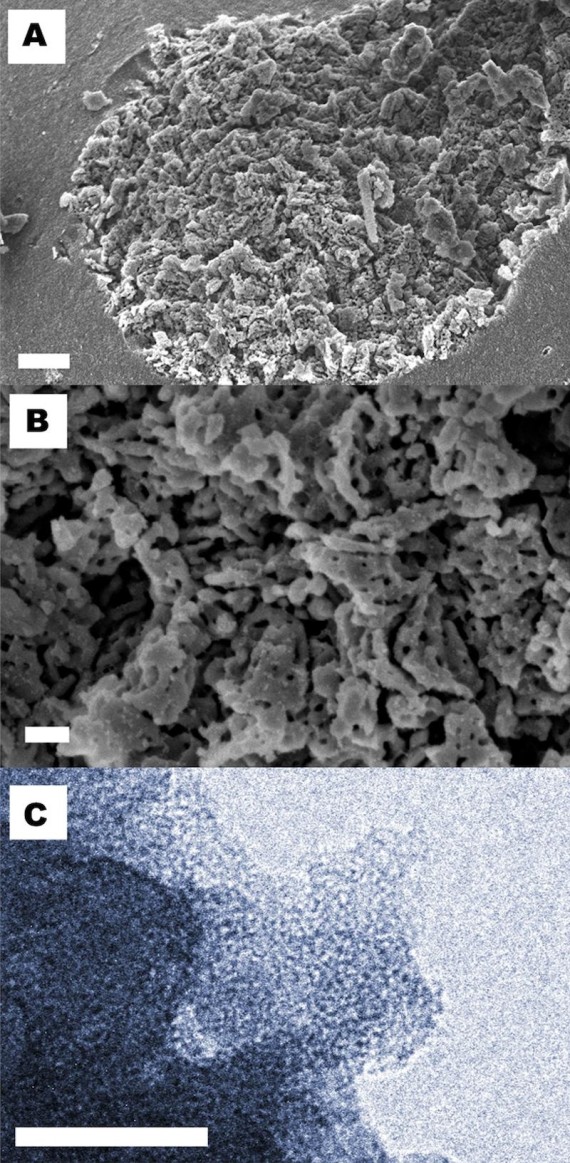Upsalite — an incredible new material possessing record-breaking surface area and water adsorption abilities, was recently discovered by researchers at Uppsala University in Sweden.

The material — according to the researchers — should allow for drastic reductions in the total amount of energy needed to control environmental moisture in the electronics and drug formulation industries, as well as in warehouses, storage facilities, etc. As well as having, no doubt, a number of other potential applications — such as toxic waste collection, chemical spill clean-up, oils spill clean-up, odor control, etc.
“In contrast to what has been claimed for more than 100 years in the scientific literature, we have found that amorphous magnesium carbonate can be made in a very simple, low-temperature process,” states Johan Goméz de la Torre, researcher at the Nanotechnology and Functional Materials Division.
Upsalite is essentially just a water-free disordered form of magnesium carbonate. Ordered forms of magnesium carbonate are actually very common in nature — both forms with water, and those without water — but water-free disordered forms aren’t, and a century of trying to manufacture the material in the lab has proved unsuccessful, until now of course. “In 1908, German researchers claimed that the material could indeed not be made in the same way as other disordered carbonates, by bubbling CO2 through an alcoholic suspension. Subsequent studies in 1926 and 1961 came to the same conclusion.”
“A Thursday afternoon in 2011, we slightly changed the synthesis parameters of the earlier employed unsuccessful attempts, and by mistake left the material in the reaction chamber over the weekend. Back at work on Monday morning we discovered that a rigid gel had formed and after drying this gel we started to get excited,” explains Johan Goméz de la Torre.
// < ![CDATA[
// < ![CDATA[ google_ad_client = "ca-pub-6260354429531949"; /* Nathan CT */ google_ad_slot = "3201144213"; google_ad_width = 468; google_ad_height = 60;
// ]]>
// < ![CDATA[
// < ![CDATA[
// ]]>The researchers then spent the next year performing a detailed materials analysis of the gel, and also working to fine tune the experiment that produced it. Somewhat amusingly, some of the chemistry details necessary for understanding the reaction mechanism were only available in a rather old Russian PhD thesis.
“After having gone through a number of state of the art materials characterization techniques it became clear that we had indeed synthesized the material that previously had been claimed impossible to make,” states Maria Strømme, a professor of nanotechnology and head of the nanotechnology and functional materials division.
While the realization that they had indeed produced a material that had long been thought to be impossible to create was somewhat surprising, the real surprise came when the researchers discovered the properties that the new material possessed. They discovered that Upsalite possessed “the highest surface area measured for an alkali earth metal carbonate; 800 square meters per gram.”
“This places the new material in the exclusive class of porous, high surface area materials including mesoporous silica, zeolites, metal organic frameworks, and carbon nanotubes,” states Strømme.
Uppsala University has more:
In addition we found that the material was filled with empty pores all having a diameter smaller than 10 nano meters. This pore structure gives the material a totally unique way of interacting with the environment leading to a number of properties important for application of the material. Upsalite is for example found to absorb more water at low relative humidities than the best materials presently available; the hydroscopic zeolites, a property that can be regenerated with less energy consumption than is used in similar processes today.
“This, together with other unique properties of the discovered impossible material is expected to pave the way for new sustainable products in a number of industrial applications,” states Maria Strømme.
The material will be commercialized though the University spin-out company Disruptive Materials.
The new research was just published in the journal PLOS ONE.
[source: http://feeds.importantmedia.org/~r/IM-greenbuildingelements/~3/-UkFQjs7NMs/]

Leave a Reply
You must be logged in to post a comment.